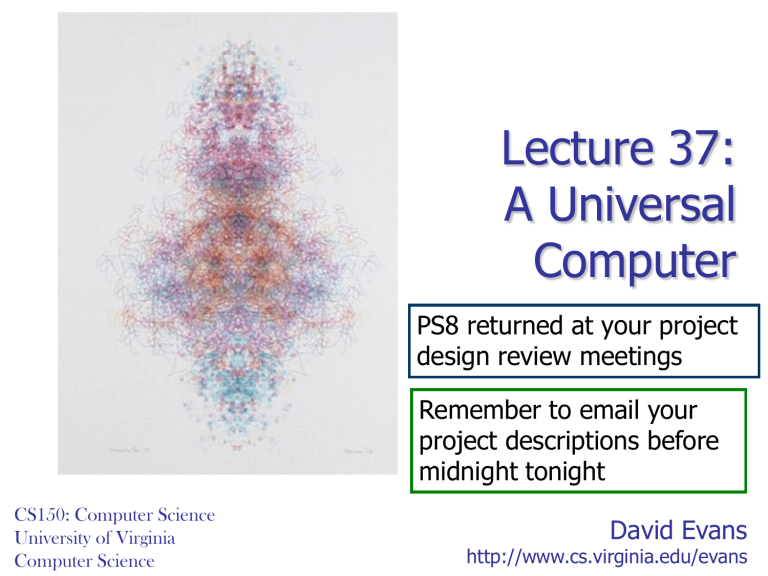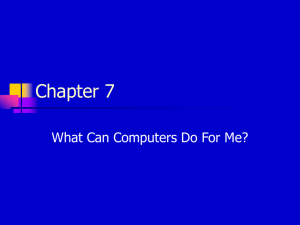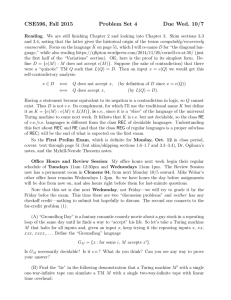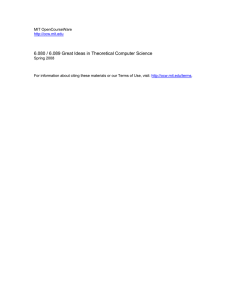Lecture 37: A Universal Computer
advertisement

Lecture 37:
A Universal
Computer
PS8 returned at your project
design review meetings
Remember to email your
project descriptions before
midnight tonight
CS150: Computer Science
University of Virginia
Computer Science
David Evans
http://www.cs.virginia.edu/evans
Turing Machine: FSM + Infinite Tape
• Start:
– FSM in Start State
– Input on Infinite Tape
– Tape head at start of input
• Step:
– Read current input symbol from tape
– Follow transition rule from current state on input
• Write symbol on tape
• Move L or R one square
• Update FSM state
• Finish: Transition to halt state
Lecture 37: Universal Computing Machines
2
Turing Machine
...
#
1
0
1
1
0
1
1
0
Input: #
Write: #
Move:
Start
1
Input: 1
Write: 1
Move:
1
1
0
1
Input: 1
Write: 0
Move:
2
Input: 0
Write: #
Move:
Input: 0
Write: 0
Move:
Lecture 37: Universal Computing Machines
1
3
3
1
1
#
...
Adding
• Input on tape:
...#nknk-1...n0+mlml-1...m0#.....
– Number represented in binary
• Output:
...#rdrd-1...r0#.....
where r = n + m
Can we implement addition with a TM?
Lecture 37: Universal Computing Machines
4
Adder TM (Start)
Input: +
Write: +
Move: L
0, 0, R
+, +, L
1, 1, R
Start
2: look
for
digit
1:
look
for +
0, X, R
1, X, R
3:
addin
g to 0
Lecture 37: Universal Computing Machines
X, X, L
5
4:
addin
g to 1
0, 0, R
+, +, L
1, 1, R
Start
1:
look
for +
0, X, R
X, X, L
2: look
for
digit
1, X, R
3:
addin
g to 0
0, 0, R
4:
addin
g to 1
1, 1, R
#, #, L
5: look
for digit
Lecture 37: Universal Computing Machines
0, 0, R
1, 1, R
#, #, L
6: look
for digit
6
1, X, R
3:
addin
g to 0
0, 0, R
4:
addin
g to 1
1, 1, R
#, #, L
X, X, L
5: look
for digit
0, X, R
7:
0+0
Lecture 37: Universal Computing Machines
0, 0, R
1, 1, R
#, #, L
6: look
for digit
1, X, R
X, X, L
0, X, R
1, X, R
8:
0+1
7
9:
1+1
#, #, L
5: look
for digit
X, X, L
X, X, L
0, X, R
1, X, R
8:
0+1
7:
0+0
X, X, R
6: look
for digit
1, X, R
0, X, R
#, #, L
9:
1+1
#, #, R
go to end of answer
digits, write 0
21: return
for next
digits, carry
1
20: return for
next digits, no
carry
Lecture 37: Universal Computing Machines
8
Turing Machine
z z
z
z
z
z
z
z
), X, L
), #, R
(, #, L
2:
look
for (
1
Start
(, X, R
#, 1, -
HALT
#, 0, -
Finite State Machine
z
z
z
z
z
z
z
z z
z
z
TuringMachine ::= < Alphabet, Tape, FSM >
Alphabet ::= { Symbol* }
Tape ::= < LeftSide, Current, RightSide >
OneSquare ::= Symbol | #
Current ::= OneSquare
LeftSide ::= [ Square* ]
RightSide ::= [ Square* ]
Everything to left of LeftSide is #.
Everything to right of RightSide is #.
Lecture 37: Universal Computing Machines
z
9
Describing Finite State Machines
TuringMachine ::= < Alphabet, Tape, FSM >
FSM ::= < States, TransitionRules, InitialState, HaltingStates >
States ::= { StateName* }
InitialState ::= StateName
must be element of States
HaltingStates ::= { StateName* } all must be elements of States
TransitionRules ::= { TransitionRule* }
TransitionRule ::=
< StateName, ;; Current State Transition Rule is a procedure:
OneSquare, ;; Current square Inputs: StateName, OneSquare
Outputs: StateName, OneSquare,
StateName, ;; Next State
Direction
OneSquare, ;; Write on tape
Direction > ;; Move tape
Direction ::= L, R, #
Lecture 37: Universal Computing Machines
10
), #, R
1
Start
#, 1, #
), X, L
(, X, R
HALT
(, #, L
2: look
for (
#, 0, #
Example
Turing
Machine
TuringMachine ::= < Alphabet, Tape, FSM >
FSM ::= < States, TransitionRules, InitialState, HaltingStates >
Alphabet ::= { (, ), X }
States ::= { 1, 2, HALT }
InitialState ::= 1
HaltingStates ::= { HALT }
TransitionRules ::= { < 1, ), 2, X, L >,
< 1, #, HALT, 1, # >,
< 1, ), #, R >,
< 2, (, 1, X, R >,
< 2, #, HALT, 0, # >,
< 2, ), #, L >,}
Lecture 37: Universal Computing Machines
11
Enumerating Turing Machines
• Now that we’ve decided how to describe
Turing Machines, we can number them
• TM-5023582376 = balancing parens
• TM-57239683
= even number of 1s
• TM= Photomosaic Program
• TM= WindowsXP
3523796834721038296738259873
3672349872381692309875823987609823712347823
Not the real
numbers – they
would be much
bigger!
Lecture 37: Universal Computing Machines
12
Universal Turing Machine
P
Number
of TM
I
Input
Tape
Universal
Turing
Machine
Output
Tape
for running
TM-P
in tape I
Can we make a Universal Turing Machine?
also, just a number!
Lecture 37: Universal Computing Machines
13
Yes!
• People have designed Universal Turing
Machines with
– 4 symbols, 7 states (Marvin Minsky)
– 4 symbols, 5 states
– 2 symbols, 22 states
– 18 symbols, 2 states
– 2 states, 5 symbols (Stephen Wolfram)
• No one knows what the smallest possible
UTM is
Lecture 37: Universal Computing Machines
14
Manchester Illuminated Universal Turing Machine, #9
from http://www.verostko.com/manchester/manchester.html
Lecture 37: Universal Computing Machines
15
Church-Turing Thesis
• Any mechanical computation can be
performed by a Turing Machine
• There is a TM-n corresponding to every
computable problem
• We can any “normal” (classical mechanics)
computer with a TM
– If a problem is in polynomial time on a TM, it is
in polynomial time on an iMac, Cray, Palm, etc.
– But maybe not a quantum computer! (later
class)
Lecture 37: Universal Computing Machines
16
Universal Language
• Is Scheme/Charme/Python as powerful as
a Universal Turing Machine?
Yes: show we can simulate a UTM with a Scheme program
• Is a Universal Turing Machine as powerful
as Scheme/Charme/Python?
Can we simulate a Scheme interpreter with a TM?
Lecture 37: Universal Computing Machines
17
Complexity in Scheme
• Special Forms
If we have lazy evaluation and
don’t care about abstraction,
we don’t need these.
– if, cond, define, etc.
• Primitives
– Numbers (infinitely many)
Hard to get rid of?
– Booleans: #t, #f
– Functions (+, -, and, or, etc.)
• Evaluation Complexity
– Environments (more than ½ of our eval code)
Can we get rid of all this and still have a useful language?
Lecture 37: Universal Computing Machines
18
-calculus
Alonzo Church, 1940
(LISP was developed from -calculus,
not the other way round.)
term = variable
| term term
| (term)
| variable . term
Lecture 37: Universal Computing Machines
19
What is Calculus?
•
In High School:
d/dx xn = nxn-1
[Power Rule]
d/dx (f + g) = d/dx f + d/dx g [Sum Rule]
Calculus is a branch of mathematics that
deals with limits and the differentiation
and integration of functions of one or
more variables...
Lecture 37: Universal Computing Machines
20
Real Definition
• A calculus is just a bunch of rules for
manipulating symbols.
• People can give meaning to those
symbols, but that’s not part of the
calculus.
• Differential calculus is a bunch of rules
for manipulating symbols. There is an
interpretation of those symbols
corresponds with physics, slopes, etc.
Lecture 37: Universal Computing Machines
21
Lambda Calculus
• Rules for manipulating strings of
symbols in the language:
term = variable
| term term
| (term)
| variable . term
• Humans can give meaning to those
symbols in a way that corresponds to
computations.
Lecture 37: Universal Computing Machines
22
Why?
• Once we have precise and formal rules for
manipulating symbols, we can use it to
reason with.
• Since we can interpret the symbols as
representing computations, we can use it
to reason about programs.
Lecture 37: Universal Computing Machines
23
Evaluation Rules
-reduction
(renaming)
y. M v. (M [y v])
where v does not occur in M.
-reduction
(substitution)
(x. M)N M [ x N ]
Lecture 37: Universal Computing Machines
24
Charge
• Project Descriptions due before midnight
tonight
• Exam 2 due Friday at 12:02 pm
(beginning of class)
• Friday’s class: student talks about
research and industry
Lecture 37: Universal Computing Machines
25




